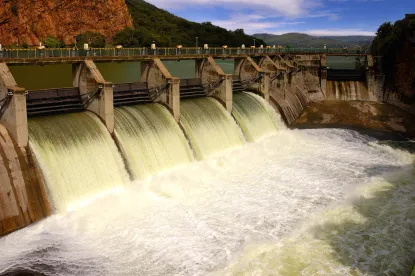Supreme Court Reinstates Trump Clean Water Act 401 Rule
On April 6, 2022, the U.S Supreme Court granted an application—in a 5-4 vote—for a stay pending appeal of the U.S. District Court for the Northern District of California’s October 21, 2021, vacatur of the 2020 Clean Water Act (CWA) Section 401 Rule. The application was filed by the National Hydropower Association (NHA) and other industry trade associations, along with a number of states that intervened in defense of the Trump Administration’s 2020 Rule. The U.S. Court of Appeals for the Ninth Circuit had earlier denied the stay on February 24, 2022. According to the stay order, the stay, which has the effect of reinstating the 2020 Rule, will remain in effect until the Supreme Court either denies certiorari of a Ninth Circuit decision on the vacatur, or grants certiorari and renders a final judgment. Some, including Justice Kagan in her dissent joined by three other members of the Court, have interpreted the stay order to signal the Supreme Court majority’s interest in reviewing any Ninth Circuit decision striking down the rule. Meanwhile, the U.S. Environmental Protection Agency (EPA) says that it is working on proposed changes to the 2020 Rule which it expects to finalize in Spring 2023.
Diverse Coalition Proposes Hydroelectric Licensing Reforms
NHA, several Tribal Nations, and a number of river advocacy groups have announced agreement on proposed amendments to Part I of the Federal Power Act (FPA) to improve the Federal Energy Regulatory Commission (FERC) hydroelectric licensing process. Among the highlights of the proposed legislation:
-
Requiring FERC to put in place an expedited licensing process for certain new hydroelectric developments at existing federal and non-federal dams
-
Requiring a streamlined licensing process for closed-loop and off-stream pumped storage projects
-
Requiring FERC and other agencies and Tribes with regulatory authority over a project to produce a joint schedule and coordinate efforts for obtaining the necessary permits and regulatory approvals
-
Requiring reliance on existing studies where practicable and avoiding duplication of studies
-
New requirements for FERC to consider, in issuing licenses: reasonably foreseeable economic factors relating to a project’s value; reasonably foreseeable effects of climate change on the water resources to be utilized by a project as well as the project’s climate benefits; and applicable federal treaty obligations to Tribes
-
Requiring federal land management agency conditions on a license under Section 4(e) of the FPA and fishway prescriptions under FPA Section 18 be tied to project effects
-
Shifting authority to issue mandatory license conditions under Section 4(e) for projects located within Indian reservations from the U.S. Department of the Interior (Interior) to Tribes
-
Requiring federal land management agencies to consult with Tribes in setting 4(e) conditions where the project may affect treaty hunting and fishing rights
-
Providing deference to fish and wildlife recommendations of Tribes under FPA Section 10(j) where a project could affect treaty hunting and fishing rights
-
Direct reimbursement of costs through the FERC annual charges program to other federal agencies participating in the FERC licensing process, as well as providing limited funding for state agency and Tribal participation
-
Requiring FERC to conduct a rulemaking to establish more predictable license surrender procedures
The legislative proposal was a product of a Stanford University Woods Institute for the Environment Uncommon Dialogue on hydropower and river conservation, first convened in 2018.
D.C. District Court Mostly Upholds NMFS on Refusal to List River Herring
On March 31, 2022, the U.S. District Court for the District of Columbia denied a petition by conservation groups to list river herring—alewife and blueback herring—as threatened under the Endangered Species Act (ESA). Nat. Res. Def. Council, Inc. v. Coit, No. 20-cv-1150, -- F. Supp. 3d – (D.D.C. Mar. 31, 2022). In a 2013 listing decision, the National Marine Fisheries Service (NMFS) had earlier determined that listing was not warranted. The District Court vacated that listing decision following challenge by the conservation groups and remanded to the agency, which reached the same finding in a 2019 listing decision. On appeal of the 2019 listing decision, the District Court this time agreed with NMFS and denied the challenge, remanding to the agency for further explanation on just two points related to the blueback herring population in Southern New England while leaving the listing decision in place. Listing river herring under the ESA would have widespread ramifications for dam operations throughout their range in the eastern United States.
Interior Invests in Dam Safety Project in California
On March 22, Interior announced that the Bureau of Reclamation (Reclamation) is providing $100 million in funding in order to modify and improve the B.F. Sisk Dam in California. The funding is from the $500 million provided to Reclamation by the Bipartisan Infrastructure Law to support dam safety projects, streamline construction management, and maintain operational capacity of Reclamation dams.
The dam is located south of the Sacramento-San Joaquin Delta and impounds San Luis Reservoir and provides supplemental water for the Central Valley Project and the California Department of Water Resources’ (DWR) State Water Project. In December 2019, DWR and Reclamation announced a partnership to perform a seismic upgrade of the B.F. Sisk Dam. The dam safety project would add stability berms and other features to the existing dam in order to reduce downstream public safety concerns, build water security for communities that use the water supply, and better adapt to climate change. Phase I of the project is set to begin later this year.
FWS Proposes to Reclassify the Northern Long-Eared Bat as an Endangered Species
On March 23, 2022, the U.S. Fish and Wildlife Service (FWS) published a proposed rule that would reclassify the northern long-eared bat (NLEB) from threatened to endangered status under the ESA. 87 Fed. Reg. 16,442. If finalized, the NLEB uplisting will have significant implications for developers and project proponents throughout a large portion of the United States due to the expanded application of the ESA’s take prohibition and more burdensome permitting processes. Comments on the proposed rule are due by May 23, 2022.
The NLEB is a wide-ranging species that occurs in 37 states, the District of Columbia, and eight Canadian provinces. The species was listed as threatened in 2015 primarily due to population declines associated with the spread of white-nose syndrome, a fungal pathogen that affects bats. In conjunction with the listing, FWS issued a “4(d) rule” that tailored the ESA’s prohibitions on take to only apply to certain development activities, such as actions that would affect known hibernacula and tree-removal activities near hibernacula or maternity roost trees during the summer pupping season. See 50 C.F.R. § 17.40(o). On January 28, 2020, a district court invalidated FWS’s 2015 NLEB listing rule, and directed FWS to make a new listing determination for the species. Center for Biological Diversity v. Everson, 435 F. Supp. 3d 69 (D.D.C. 2020).
In its proposal to reclassify the species as endangered, FWS found that the primary factor influencing NLEB viability continues to be white-nose syndrome and, to a lesser extent, impacts associated with wind energy mortality, climate change, and habitat loss. However, FWS notes that “habitat loss alone is not considered to be a key stressor at the species level, and habitat does not appear to be limiting.” 87 Fed. Reg. at 16,446. Notwithstanding, FWS projects that rangewide abundance will decline by 95 percent and spatial extent will decline by 75 percent from historical conditions by 2030.
Importantly, if the NLEB is reclassified as endangered, the existing 4(d) rule would be nullified (4(d) rules are only available for threatened species), and the full scope of ESA take prohibitions would apply. In addition, project proponents will likely lose the benefit of the streamlined section 7 consultation process that has applied since the initial listing decision. As a result, for activities within the range of the NLEB—such as renewable and traditional energy projects, construction of rights-of-way, commercial and industrial developments, forestry practices—project proponents should assess the need for incidental take authorization, either through an ESA section 10 incidental take permit or section 7 consultation and anticipate a more burdensome and time-consuming permitting process.
DOE Announces Grants for U.S. Tribes
On March 21, 2022, the Department of Energy (DOE) announced that nearly $9 million in funding will be distributed across more than a dozen tribal communities. This investment by DOE will supplement tribal nations in their efforts to support their communities’ energy needs and generate millions in energy savings.
These clean energy initiatives are intended to develop, or enhance, energy resources and energy security among tribal nations through a combination of solar, battery storage, hydroelectric, or geothermal advancements. Many rural tribes lack access to basic energy and internet resources. The extended partnerships, between federally recognized tribes and Alaskan Native Corporations and DOE, intend to remedy access issues through the supplemental energy grants and the Infrastructure Investment and Jobs Act.
Environmental Groups Petition EPA for a Rulemaking to Add Dams and Reservoirs to the Greenhouse Gas Reporting Program
On March 21, 2022, Earthjustice, on behalf of over 130 other organizations, submitted a petition for rulemaking to the EPA to exercise its authority under Clean Air Act Section 114(a)(1) and the Administrative Procedure Act to add dams and reservoirs as a source category under the Greenhouse Gas (GHG) Reporting Program (GHGRP). According to the petition, dams and reservoirs can emit significant levels of GHGs, including methane, carbon dioxide, and nitrous oxide. GHGs can be emitted from emission points such as turbines, spillways, and downstream water discharge. The petition cites to scientific studies that show that facilities such as the Hoover Dam and Lake Mead emit approximately 12.3 million metric tons of carbon dioxide equivalent annually, 3.1 million metric tons of which is attributable to hydropower infrastructure and power generation.
EPA first implemented the GHGRP in 2009 to track facility-level emissions from the largest sources of GHG emissions in the United States, including fuel and industrial gas suppliers, and carbon dioxide injection sites; in total there are 41 categories of reporters covered by the program. The reported data can be used to track and compare facilities’ GHG emissions to identify opportunities to cut pollution, minimize waste energy, and develop climate policy. The petition argues that adding dams and reservoirs to the GHGRP would help to create a more accurate picture of actual GHG emissions and therefore help the United States to achieve such policy goals as the Global Methane Pledge—launched in November 2021—which commits the United States (and other partners such as the European Union) to reduce global methane emissions by at least 30% from 2020 levels by 2030.
In addition, the petition claims that federal agencies commonly overlook and disregard dam and reservoir GHG emissions while conducting environmental reviews, and that the hydropower industry “false[ly] claim[s] that hydropower is a clean energy resource.” The hydropower industry reportedly is preparing a rebuttal to the petition, so stay tuned!
FERC Update – Move to Return to Business As Usual
In light of the change in Centers for Disease Control guidelines and many people returning back to their workplaces, FERC has issued two notices recently departing from their protocol for the last two years:
-
During the pandemic, FERC had been waiving the requirement for filings that required notarization or supported by sworn affidavits. On March 31, 2022, the blanket waiver was lifted. Entities that believe they have specific circumstances that warrant a continuation of the waiver will be considered on a case-by-case basis by request.
-
Similarly, the Office of Administrative Law Judges issued an order that they will resume conducting evidentiary hearings in person at FERC headquarters rather than remotely effective June 1, 2022.






 />i
/>i

